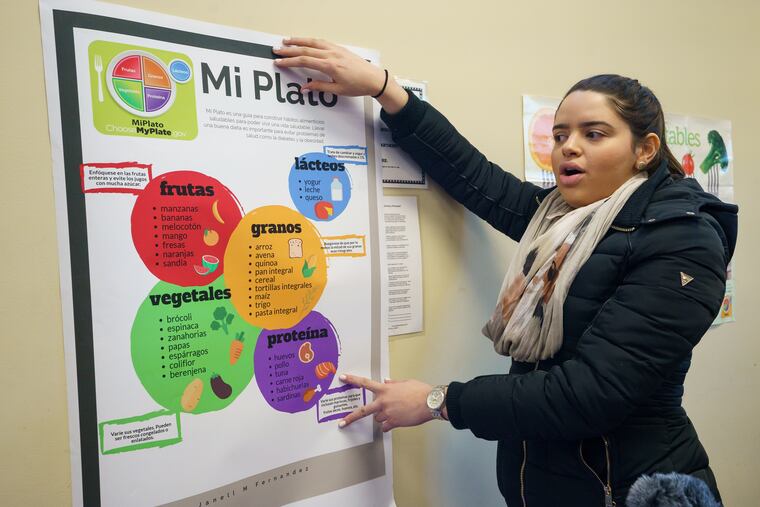Rutgers makes a push for competent Spanish-speaking health professionals in Camden
In a city with about 30,000 Spanish speakers, Camden offers a laboratory for Rutgers University’s Spanish for Health Professions.

In a round-table setting, eight Spanish-speaking students — some native speakers, others not — discuss what health disparities look like in the United States. They compare data sets, add to the conversation social factors such as family composition, talk about issues specific to Camden, and take notes.
“So, class, what could a nonintentional death be?" the instructor asks in Spanish, although her first language is English. "To drown, right?”
One student answers in English-accented Spanish, “Un choque,” meaning “a crash.” But the instructor thinks he is speaking in English.
“Choking?” she asks, to clarify.
“No, no ... un choque,” he says. This time she understands.
The conversation — showing how misunderstandings arise even among people who speak the same language — illustrates one of the reasons Rutgers-Camden’s Spanish for Health Professions program encourages future practitioners to interact with the Hispanic community. The idea is that undergraduate nursing, biology, and medical students need to develop both language and cultural competencies (the same word can mean something different if you’re from South America or the Caribbean), especially in Camden.
“It’s about promoting health and wellness, and avoid leaving people behind because they can’t communicate in the English language,” said Dana Pilla, the class' instructor and program co-director.
The need isn’t small. Camden has about 30,000 Spanish speakers — 40 percent of its population 5 or older speaks Spanish at home, according to American Community Survey data from 2012 to 2017. In 2017, only 18 graduates of New Jersey medical schools, or 4.8 percent, identified as Hispanic or Latino out of the 372 total graduates, according to a Kaiser Family Foundation report. (That’s on par with 2015 national statistics, where 5 percent of medical school graduates are Hispanic or Latino, according to an Association of American Medical Colleges' Diversity in Medical Education report.)
Although clinics and hospitals can use interpreters over the phone or in person, Camden needs all types of Spanish-speaking professionals in the health industry, from case managers and front desk personnel to nurses and doctors, as patients have a “different connection” with providers that speak their language, said Lisa Mojica, a bilingual patient navigator with the Camden Coalition of Healthcare Providers.
“We need more Spanish-speaking, native-speaking physicians, because some patients need to feel comfortable, and find that sense of trust in providers that speak Spanish,” she said.
Although Carmen De Jesús considers English her first language, the 70-year-old Camden resident from Puerto Rico says she lacks proficiency after the many trips she made between the island and the mainland during her childhood.
“I’m too old to store so many words in the hard drive,” she said about her lack of vocabulary.
Still, the primary doctor she’s been seeing since 2015 for her muscular dystrophy refuses to allow an interpreter in on her appointments, at which De Jesús says the two often argue about her diet and medication.
The doctor "tells me that we understand each other fine, so I’ve started to think that I’m the one who believes that I can’t connect with her,” De Jesús said.
A 2008 article in the American Medical Association Journal of Ethics recommended that physicians — not patients — be the ones to learn another language.
Doctors have to treat diseases given their patients' reality, which must include whether the patients lack proficiency in English, the article says. It’s also easier to obtain resources to teach Spanish to a small number of physicians than it is for, say, 30,000 prospective patients to learn English.
“The ethical case for all doctors being proficient in Spanish is based on the idea that all patients should have control of their health-care decisions,” the paper read.
In the Rutgers program — which includes classes such as Spanish for health professionals, civic engagement, and community interpretation — not only are students limited to speaking Spanish in class, they practice the language in a health-related context. They learn about the various medical terminologies used in Latin America and the Caribbean, and visit community-based organizations and health clinics in Camden to serve as facilitators for Spanish-speaking residents looking for health services or guidance. Only enrolled students can take individual classes or complete the certificate program.
The Salvation Army Kroc Center in Camden serves as a laboratory for the students to develop solutions and discuss real-life challenges with people attending the gym or Cooper University Hospital’s clinic there. Recently, students discussed diet and nail care with people who may have diabetes.
“Students learn from classmates' experience and from the residents that visit the center a way to develop the compassion needed to work with patients or clients,” said Pilla.
Janell Fernández, who is taking the civic engagement class, found that Spanish-speakers “open up” with her because they can communicate better despite being in a “culturally different place.”
“I can relate to the culture clash that people go through when they come here for the first time, so this makes a huge difference, because it makes others feel welcome, at least, when it comes to the language aspect,” said Fernández, 21, who was brought by her parents from the Dominican Republic when she was 12. She hasn’t decided whether she wants to be a doctor or a nurse.
Sujay Ratna, 19, moved from Virginia to study biology at Rutgers-Camden. Having taken Spanish classes in middle and high school, it’s the first time he’s found a way to put those skills to practice.
“This class has opened my eyes to the actual applications of Spanish, and, especially since I’m going to be a doctor in the future, I really like the health aspect to it,” he said.